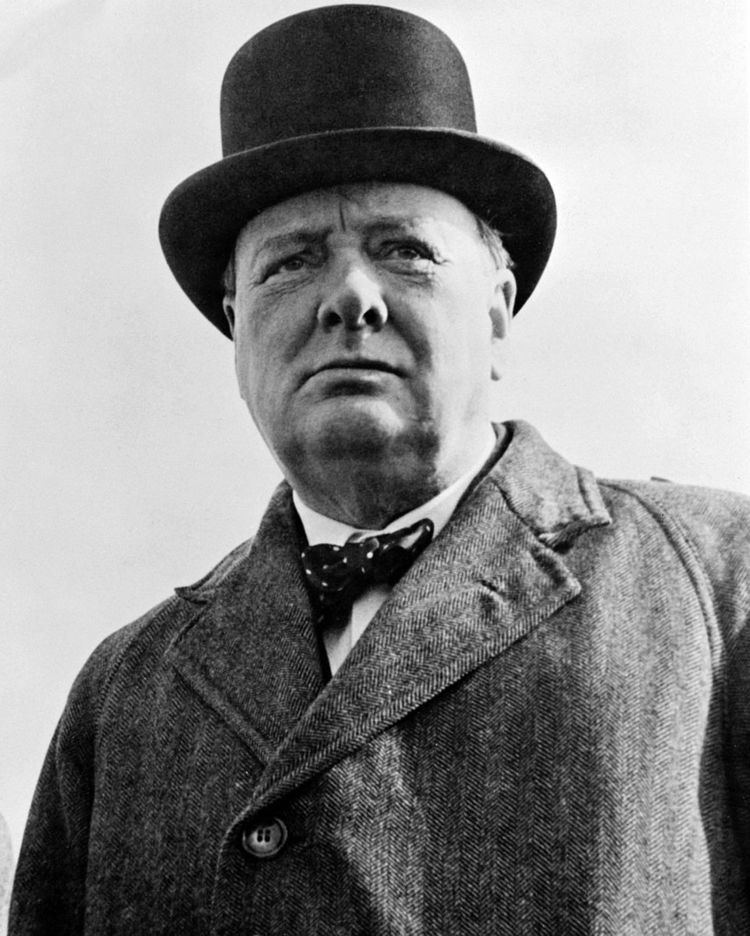The Churchill war ministry was a Conservative-led coalition government in the United Kingdom, which lasted for most of World War II. It was led by Winston Churchill, as Prime Minister of the United Kingdom. Formed in 1940, within a year of the war's outbreak, it lasted until 23 May 1945, shortly after the defeat of Nazi Germany, when Churchill resigned and an election was called.
The war ministry was followed by the Churchill caretaker ministry which in turn lasted until 26 July 1945 when the results of the general election brought Labour into government, led by Clement Attlee.
Red indicates a member of the Labour Party, whilst blue indicates a member of the Conservative Party. Grey indicates an independent.
Members of the War Cabinet are in bold face.
August 1940: Lord Beaverbrook (a Canadian-British citizen), Minister of Aircraft Production, joins the War Cabinet
October 1940: Sir John Anderson succeeds Neville Chamberlain as Lord President. Sir Kingsley Wood, the Chancellor of the Exchequer, and Ernest Bevin, the Minister of Labour, enter the War Cabinet. Lord Halifax assumes the additional job of Leader of the House of Lords.
December 1940: Anthony Eden succeeds Lord Halifax as Foreign Secretary. Halifax remains nominally in the Cabinet as Ambassador to the United States. His successor as Leader of the House of Lords is not in the War Cabinet.
May 1941: Lord Beaverbrook ceased to be Minister of Aircraft Production, but remains in the Cabinet as Minister of State. His successor was not in the War Cabinet.
June 1941: Lord Beaverbrook becomes Minister of Supply, remaining in the War Cabinet.
1941: Oliver Lyttelton enters the Cabinet as Minister Resident in the Middle East.
4 February 1942: Lord Beaverbrook becomes Minister of War Production; his successor as Minister of Supply is not in the War Cabinet.
19 February 1942: Beaverbrook resigns and no replacement Minister of War Production is appointed for the moment. Clement Attlee becomes Secretary of State for Dominion Affairs and Deputy Prime Minister. Sir Stafford Cripps succeeds Attlee as Lord Privy Seal and takes over the position of Leader of the House of Commons from Churchill. Sir Kingsley Wood leaves the War Cabinet, though remaining Chancellor of the Exchequer.
22 February 1942: Arthur Greenwood resigns from the War Cabinet.
March 1942: Oliver Lyttelton fills the vacant position of Minister of Production ("War" was dropped from the title). Richard Gardiner Casey (a member of the Australian Parliament) succeeds Oliver Lyttelton as Minister Resident in the Middle East.
October 1942: Sir Stafford Cripps retires as Lord Privy Seal and Leader of the House of Commons and leaves the War Cabinet. His successor as Lord Privy Seal is not in the Cabinet, Anthony Eden takes the additional position of Leader of the House of Commons. The Home Secretary, Herbert Morrison, enters the Cabinet.
September 1943: Sir John Anderson succeeds Sir Kingsley Wood (deceased) as Chancellor of the Exchequer, remaining in the War Cabinet. Clement Attlee succeeds Anderson as Lord President, remaining also Deputy Prime Minister. Attlee's successor as Dominions Secretary is not in the Cabinet.
November 1943: Lord Woolton enters the Cabinet as Minister of Reconstruction.
January to November 1944: Lord Moyne replaces Richard Gardiner Casey as Minister Resident in the Middle East.

